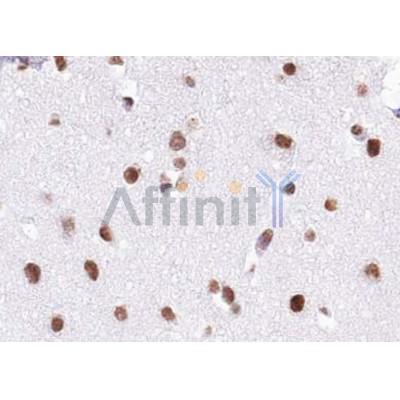BRD7 Antibody - #DF12094
| Product: | BRD7 Antibody |
| Catalog: | DF12094 |
| Description: | Rabbit polyclonal antibody to BRD7 |
| Application: | WB IHC IF/ICC |
| Reactivity: | Human, Mouse, Rat |
| Prediction: | Pig, Zebrafish, Bovine, Horse, Sheep, Rabbit, Dog, Chicken, Xenopus |
| Mol.Wt.: | 70-74 kDa; 74kD(Calculated). |
| Uniprot: | Q9NPI1 |
| RRID: | AB_2844899 |
Related Downloads
Protocols
Product Info
*The optimal dilutions should be determined by the end user.
*Tips:
WB: For western blot detection of denatured protein samples. IHC: For immunohistochemical detection of paraffin sections (IHC-p) or frozen sections (IHC-f) of tissue samples. IF/ICC: For immunofluorescence detection of cell samples. ELISA(peptide): For ELISA detection of antigenic peptide.
Cite Format: Affinity Biosciences Cat# DF12094, RRID:AB_2844899.
Fold/Unfold
75 kDa bromodomain protein; BP75; BRD 7; BRD7; BRD7_HUMAN; Bromodomain containing 7; bromodomain containing protein 7; Bromodomain-containing protein 7; CELTIX 1; CELTIX1; NAG4; Protein CELTIX-1;
Immunogens
A synthesized peptide derived from human BRD7, corresponding to a region within the internal amino acids.
- Q9NPI1 BRD7_HUMAN:
- Protein BLAST With
- NCBI/
- ExPASy/
- Uniprot
MGKKHKKHKSDKHLYEEYVEKPLKLVLKVGGNEVTELSTGSSGHDSSLFEDKNDHDKHKDRKRKKRKKGEKQIPGEEKGRKRRRVKEDKKKRDRDRVENEAEKDLQCHAPVRLDLPPEKPLTSSLAKQEEVEQTPLQEALNQLMRQLQRKDPSAFFSFPVTDFIAPGYSMIIKHPMDFSTMKEKIKNNDYQSIEELKDNFKLMCTNAMIYNKPETIYYKAAKKLLHSGMKILSQERIQSLKQSIDFMADLQKTRKQKDGTDTSQSGEDGGCWQREREDSGDAEAHAFKSPSKENKKKDKDMLEDKFKSNNLEREQEQLDRIVKESGGKLTRRLVNSQCEFERRKPDGTTTLGLLHPVDPIVGEPGYCPVRLGMTTGRLQSGVNTLQGFKEDKRNKVTPVLYLNYGPYSSYAPHYDSTFANISKDDSDLIYSTYGEDSDLPSDFSIHEFLATCQDYPYVMADSLLDVLTKGGHSRTLQEMEMSLPEDEGHTRTLDTAKEMEITEVEPPGRLDSSTQDRLIALKAVTNFGVPVEVFDSEEAEIFQKKLDETTRLLRELQEAQNERLSTRPPPNMICLLGPSYREMHLAEQVTNNLKELAQQVTPGDIVSTYGVRKAMGISIPSPVMENNFVDLTEDTEEPKKTDVAECGPGGS
Predictions
Score>80(red) has high confidence and is suggested to be used for WB detection. *The prediction model is mainly based on the alignment of immunogen sequences, the results are for reference only, not as the basis of quality assurance.
High(score>80) Medium(80>score>50) Low(score<50) No confidence
Research Backgrounds
Acts both as coactivator and as corepressor. May play a role in chromatin remodeling. Activator of the Wnt signaling pathway in a DVL1-dependent manner by negatively regulating the GSK3B phosphotransferase activity. Induces dephosphorylation of GSK3B at 'Tyr-216'. Down-regulates TRIM24-mediated activation of transcriptional activation by AR (By similarity). Transcriptional corepressor that down-regulates the expression of target genes. Binds to target promoters, leading to increased histone H3 acetylation at 'Lys-9' (H3K9ac). Binds to the ESR1 promoter. Recruits BRCA1 and POU2F1 to the ESR1 promoter. Coactivator for TP53-mediated activation of transcription of a set of target genes. Required for TP53-mediated cell-cycle arrest in response to oncogene activation. Promotes acetylation of TP53 at 'Lys-382', and thereby promotes efficient recruitment of TP53 to target promoters. Inhibits cell cycle progression from G1 to S phase.
Nucleus.
Research Fields
· Human Diseases > Cancers: Specific types > Hepatocellular carcinoma. (View pathway)
Restrictive clause
Affinity Biosciences tests all products strictly. Citations are provided as a resource for additional applications that have not been validated by Affinity Biosciences. Please choose the appropriate format for each application and consult Materials and Methods sections for additional details about the use of any product in these publications.
For Research Use Only.
Not for use in diagnostic or therapeutic procedures. Not for resale. Not for distribution without written consent. Affinity Biosciences will not be held responsible for patent infringement or other violations that may occur with the use of our products. Affinity Biosciences, Affinity Biosciences Logo and all other trademarks are the property of Affinity Biosciences LTD.


